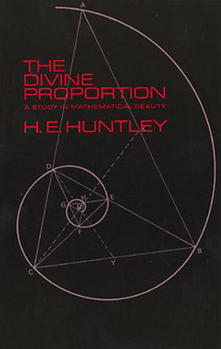The Divine Proportion
Select Format
Select Condition 
Book Overview
Engaging introduction to that curious feature of mathematics which provides framework for so many structures in biology, chemistry, and the arts. Discussion ranges from theories of biological growth... This description may be from another edition of this product.
Format:Paperback
Language:English
ISBN:0486222543
ISBN13:9780486222547
Release Date:June 1970
Publisher:Dover Publications
Length:208 Pages
Weight:0.50 lbs.
Dimensions:0.5" x 5.4" x 8.4"
Customer Reviews
3 ratings
A Cogent Reference of Beauty
Published by Thriftbooks.com User , 19 years ago
Anyone who rates this book on "fact" or "truth" will be very disappointed. Both are subjective. The objective of Huntley is to demonstrate a natural pattern in nature that exists regardless of theory, ego, and "truth." That is beauty and this book is well worth the read. There is a design.
Solid intro to the golden rectangle
Published by Thriftbooks.com User , 24 years ago
This book is perfect if you enjoyed the movie Pi and want to learn more, or if you are researching connections between math and religion, art, quality (per R. Pirsig), or aesthetics. One downer is that Huntley tries, and fails, to explain how math can be beautiful just like poetry can be beautiful. I personally think that you either dig math or you don't. Huntley should assume that anyone reading his/her book is at least interested and therefore skip the "math can be pretty too" lesson. Beyond that, though, the book is a thorough introduction to phi and the golden ratio. Huntley more than makes up for his mentioned faults by providing numerous equations, proofs, plots, and diagrams. The math level is pre-calculus with emphasis on geometry. I recommend reading this with plenty of scratch paper handy so that you can work along with the text and prove to yourself how deep this rabbit hole goes.
Very fun book, despite a few far-fetches
Published by Thriftbooks.com User , 24 years ago
Can one write a whole book about a number? Well this book is basically about the golden ratio ( [1 + sqrt(5)]/2 = 1.618...]), usually represented by the greek letter "phi" (and I'll refer to this number here as phi). The book gives tons of examples where phi shows up, and it does amazingly show up in places where one might never expect it. But the book isn't just a pile of examples. As the title implies, it is also about math and aesthetics. There are some interesting historical notes and art/aesthetics commentaries from the author. Huntley proposes (and I might be oversimplifying a bit here) that phi is a universal number of beauty, since it manifests itself in many aesthetically pleasing things, from patterns in nature to famous artwork and architechture. He also points out lots of purely mathematical curiosities of phi (like the connection between it and the fibonacci sequence, continued fractions, etc.)My only complaints is that there are a few connections that seem far-fetched. Again, the book _is_ filled with plenty of amazing examples where phi shows up, including many places where one might least expect it. But really, not every sighting of "1.6" calls for a cry of "eurika"! (And oddly enought, at some point the author criticizes the ancient Greeks for once acting like that!) The section on music had some flaws and really far-fetched claims, which is too bad, since I've always loved researching the math/music connection.But over all, the book does leave me wondering why Pi should get all the fame.





